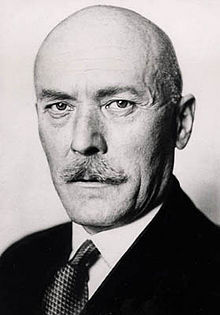- Friedrich Werner von der Schulenburg
-
Friedrich Werner von der Schulenburg 
Born 20 November 1875
Kemberg, German EmpireDied 10 November 1944 (aged 68)
Berlin, Plötzensee PrisonNationality German Occupation Diplomat Spouse Elisabeth von Sobbe (1908 - 1910) Children Christa-Wernfriedis von der Schulenburg Friedrich-Werner Graf von der Schulenburg (20 November 1875 – 10 November 1944) was a German diplomat who served as the last German ambassador to the Soviet Union before Operation Barbarossa. He began his diplomatic career before World War I, serving as consul and ambassador in several countries. After the failed July 20 plot in 1944, Schulenburg was accused of being a co-conspirator and subsequently executed.
Contents
Diplomatic career
 Inscription on the ancient statue at the entrance of Persepolis. Envoy F.W. GRAF SCHULENBURG. 1926*1930*1931
Inscription on the ancient statue at the entrance of Persepolis. Envoy F.W. GRAF SCHULENBURG. 1926*1930*1931
Schulenburg was born in Kemberg, Saxony-Anhalt to Graf[1] Bernhard von der Schulenburg. He studied law in Lausanne, Munich and Berlin after a one-year stint in the military. In 1901, he joined the Foreign Office's consular service as a junior lawyer (Assessor). By 1903, he was already the vice-consul at Germany's consulate general in Barcelona, and in the years that followed, he found himself working at consulates in Lviv, Prague, Warsaw and Tbilisi. With the outbreak of World War I in 1914, von der Schulenburg returned to the military, and after the First Battle of the Marne was promoted to captain in October 1914 and put in charge of an artillery battery. In 1915, he went as German liaison officer to the Ottoman Army on the Armenian Front. In 1916, he took over leadership of the Georgian Legion in the struggle with Russia, until its collapse in 1917. During his time in the military, he received the Iron Cross and some high Turkish honours. After the German Empire's collapse, he was captured by the British and interned on the Turkish island of Prinkipo (now called Büyük Ada), returning to Germany in 1919. Von der Schulenburg returned to the Foreign Office Service and became consul in Beirut.
Noble estate
In the 1930s, von der Schulenburg acquired the Burg Falkenberg, a castle in the Upper Palatinate. He had it converted and renovated to serve as a retirement home. This monumental work was undertaken between 1936 and 1939.
Resistance activities
After World War I, von der Schulenburg got his diplomatic career going again, becoming, among other things, an envoy to Tehran and Bucharest. In 1934, he was appointed German ambassador to the Soviet Union. Von der Schulenburg favoured an agreement between Germany and the Soviet Union, and was instrumental in bringing about the August 1939 German-Soviet Non-Aggression Pact. After the Soviet invasion of Poland, despite the state of war between Germany and Poland, he used his position as the most senior ambassador in Moscow to allow Polish diplomats (including ambassador Wacław Grzybowski) to leave the Soviet Union, when the Soviets tried to arrest them. To the last, he tried to thwart the German attack on the Soviet Union in June 1941 through means such as hinting at the country's military strength and the unassailability of its industrial reserves. He is quoted as having said to Vyacheslav Molotov on the morning of the German attack on the Soviet Union: "For the last six years I've personally tried to do everything I could to encourage friendship between the Soviet Union and Germany. But you can't stand in the way of destiny."
After the aggression began on 22 June 1941, von der Schulenburg was interned for a few weeks, and transferred to the Soviet-Turkish border. Thereafter, von der Schulenburg was assigned leader of the Russia Committee, a Foreign Office post with no political influence that neutralized him. Later he would make his influence felt in the military opposition, to reach a quick peace agreement in the east. He was ready and willing to negotiate even with Joseph Stalin in the plotters' names. In the plans for the overthrow, Friedrich-Werner von der Schulenburg was tentatively foreseen as the new foreign minister.
After the failure of the attempt on Adolf Hitler's life on 20 July 1944, he was arrested and charged with high treason. On 23 October 1944, the Volksgerichtshof ("People's Court") sentenced him to death. He was hanged on 10 November 1944 at Plötzensee Prison in Berlin.
Marriage
He married from 1908 to 1910 Elisabeth von Sobbe (Burg bei Magdeburg, 14 March 1875 - Wolframshof, 6 July 1955), and had an only daughter:
- Christa-Wernfriedis Hanna Margarete Engelberta Gräfin von der Schulenburg (Prague, 29 December 1908 - ?), married to Max Wolfgang, Freiherr von Lindenfels (Wolframshof, 12 July 1908 - Wolframshof, 28 November 1982)
See also
- List of members of the July 20 plot
- Widerstand
- Soviet-German relations before 1941
Notes
References
- Schorske, Carl "Two German Ambassadors: Dirksen and Schulenburg" pages 477-511 from The Diplomats 1919-1939 edited by Gordon A. Craig and Felix Gilbert, Princeton, New Jersey: Princeton University Press, 1953.
External links
- Friedrich Werner von der Schulenburg in the German National Library catalogue (German)
- Plötzensee Prison
- Portrait photo Graf Friedrich Werner
Diplomatic posts Preceded by
Rudolf NadolnyGerman Ambassador to Soviet Union
1934-1941Succeeded by Categories:- Members of July 20 plot
- Executed July 20 plotters
- Executions at Plötzensee Prison
- German diplomats
- German military personnel of World War I
- Knights of the Order of Saint John (Bailiwick of Brandenburg)
- German Protestants opposed to the Third Reich
- German Resistance members
- People condemned by Nazi courts
- People executed by hanging
- 1875 births
- 1944 deaths
- Ambassadors of Germany to the Soviet Union
Wikimedia Foundation. 2010.
